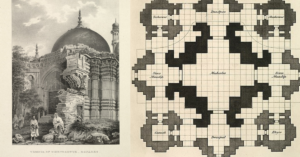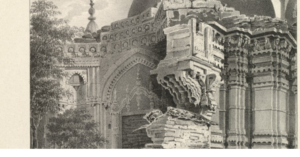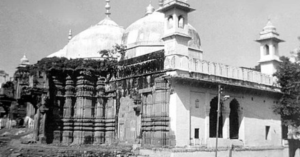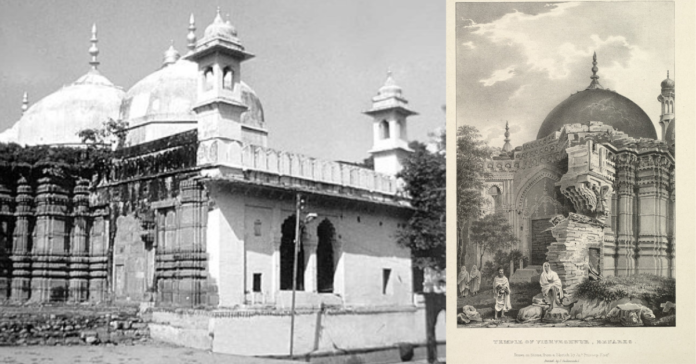Gyanvapi Mosque : Varanasi Court Update Today 2024 The court handed over to the parties the report of the survey conducted by the Archaeological Survey of India (ASI) in the Gyanvapi complex adjacent to the Kashi Vishwanath temple at 10 pm on Thursday. According to reports, there was a large Hindu temple in Gyanvapi before the construction of the present structure of the mosque.
Table of Contents
Gyanvapi Mosque : Varanasi Court Update Today 2024 Ten major takeaways from the poll report
- There was a huge central chamber and a smaller chamber on the north side of the temple that was constructed there before the mosque.
- The temple was destroyed and some of its remains were added to the mosque in the 17th century.
- The temple’s pillars and other components were mostly reused in the mosque’s construction.
- Certain pillars no longer carry Hindu symbols.
- The Hindu temple is fully enclosed by the mosque’s western wall.
- The survey turned up 32 stone slabs and stones, which attest to the location of the first Hindu temple.
- The stone slab inscriptions are written in
Gyanvapi Mosque :The Hindu side demands the right to worship
The attorney for the Hindu side, Vishnu Shankar Jain, claimed that the 839-page report contained every detail, except the restroom. The research makes it rather evident that the mosque was constructed following the temple’s demolition. Hindus ought to be able to worship there as a result. He predicted that following the ASI examination of the Shivlinga-like figure discovered in the mosque complex’s restroom, it would be evident that the figure is a Shivlinga and that numerous more similar pieces of evidence would also be discovered, supporting the Hindu side’s contention.

At this place, there was a Vishveshvara temple dedicated to the Hindu deity Shiva. It was built by Todar Mal, a prominent courtier and minister of Akbar, in collaboration with Narayan Bhatt, a prominent Brahmin scholar from Banaras, Maharashtra, in the late 16th century. The temple contributed to the establishment of Banaras as a prestigious centre of Brahmin assembly, attracting scholars from across the subcontinent. Maharashtra, to settle various disputes related to Hindu religious law.
Architectural historian Madhuri Desai hypothesizes that the temple was a system of truncated iwans with prominent pointed arches borrowed from Mughal architecture; Its exterior had carved stone.
Gyanvapi Mosque : Historicity
Diana L. One finds medieval chronicles to corroborate the Hindu belief that the Adi-Vishveshvara complex was the original home of the lingam; However, scholars have criticized Ek’s decontextualized use of medieval sources. Hans T. Becker believes that the temple destroyed in 1194 is located in the present Gyanvapi complex but is dedicated to Avimuktesvara;
However, he speculates that the Razia Mosque was not built in its place, but on top of the adjacent “Hill of Vishveshvara”, which the Hindus had – in the late 13th century – vacated the Gyanvapi site for the temple of Vishveshvara. Will force you to reclaim it. This new temple would again be destroyed by the Jaunpur Sultanate, apparently to supply building materials for mosques in their new capital.

Gyanvapi Mosque : Vishveshvara temple in early-medieval Banaras
In contrast, in his study of medieval literature, Desai rejects the existence of any Vishveshvara temple in early-medieval Banaras; He, along with other scholars, argues that it was in Kashikhand [e] that Vishveshvara was first depicted as the principal deity of the city and yet, for centuries, it remained one of the many sacred places in Banaras.
It was only after continued patronage from the Mughals starting from the end of the sixteenth century that Vishveshvara replaced Avimuktesvara as the principal temple of the city. He uses Hindu claims as a meta-narrative about Hindu civilization being continuously oppressed by Muslim invaders. part, which was reinforced through colonial instruments of knowledge production.
In September 1669, Aurangzeb ordered the demolition of the temple; A mosque at that place was probably built by Aurangzeb himself at some point. The facade was partly built over the entrance of the Taj Mahal; The temple platform was left largely untouched to serve as a mosque courtyard, and the southern wall – with its pointed arches, external mouldings and archways – was converted into the qibla wall. Other buildings on the campus were saved.

Gyanvapi Mosque : The Mosque Premises and Exercise
Oral accounts indicate that despite the desecration, Brahmin priests were allowed to remain in the mosque premises and exercise their privileges over Hindu pilgrimage issues. The remains of the temple, especially the platform, remain a popular centre for Hindu pilgrims. The mosque came to be known as the Alamgiri Mosque—named after Aurangzeb—but over time, the present name was colloquially adopted, derived from the nearby sacred reservoir – Gyan Vapi (“well of knowledge”). “) – which, in all probability, predates the temple.





